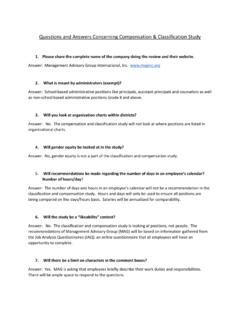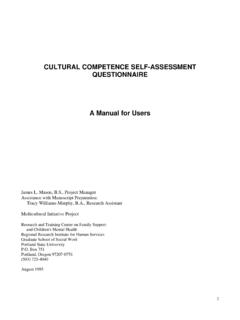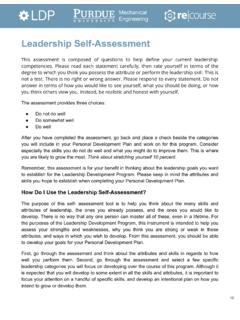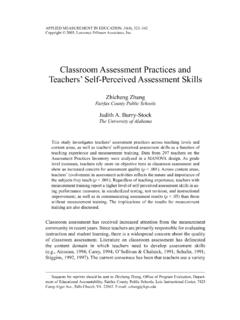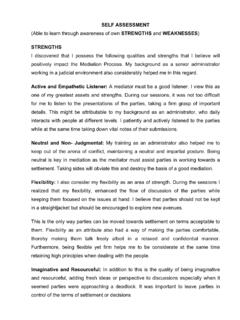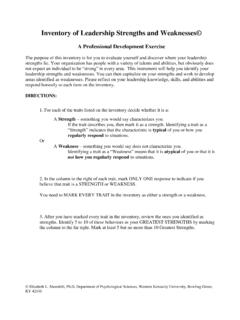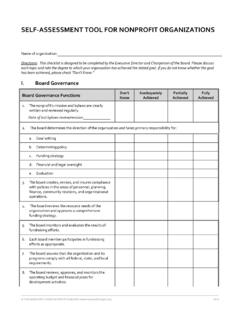Transcription of MTSS TOOLKIT Self-Reflection and Assessment
1 JCPS ESSENTIAL SYSTEM 2 EFFECTIVE USE OF DATASelf-Reflectionand AssessmentMTSS TOOLKITThe purpose of the MTSS (Increased Engagement) Toolkits is to present a select group of high-yield practices that not only foster relationships between adults and students, but also improve outcomes for ALL youth. The toolkits will have a laser-like focus on six, research-based, pedagogical practices resulting in increased engagement, more effective tier-one instruction, and ultimately, increased student achievement. The Multi-Tiered Systems of Support (MTSS) Academic Resource Department will provide instructional support to enhance pedagogical-efficacy for all ToolkitsPAGE 2 MTSS TOOLKIT 2 // self -REFLECTION AND ASSESSMENTPAGE 3 Reflecting on Learning to Empower Student AchievementJCPS ESSENTIAL SYSTEM 2 EFFECTIVE USE OF DATAMTSS TOOLKITSelf-Reflectionand Assessment (High-Yield Instructional Practices)
2 self -Reported Grades Metacognitive Strategies self -Verbalization/ self -QuestioningPAGE 4 PAGE 5 TABLE OF CONTENTS061308255052546 Essential Systems for a Strong Learning Environment System 2: Effective Use of Data BlueprintSelf-Reflection and Assessment IntroductionApplicationStrategies For ImplementationTeacher self - Assessment ResourcesMTSS TOOLKIT 2 // self -REFLECTION AND ASSESSMENTEFFECTIVE USEOF DATA The school collects, analyzes, and uses key data points to inform academic and non-academic decision FEEDBACK AND PROFESSIONAL LEARNINGThe District and school have identified common frameworks (leadership, content, pedagogy, systems)
3 And use structured walkthroughs, feedback and coaching, and professional learning to improve leadership and instructional MONITORING AND ANALYSIS OF STUDENT WORK Teams of teachers and school leadership collect/review/analyze data and student work samples to determine student progress towards meeting mastery and application of standards and performance ANDBEHAVIORAL SUPPORT Teachers use academic and behavioral data to prescribe short- and long-term supports for students to meet and exceed standards and strengthen their sense of IMPLEMENTATION The school identifies essential.
4 Grade-level standards that a student must reach to demonstrate high levels of learning and commits to ensure mastery and application for all students. This serves as the foundation for instructional transformation and informs every other system in this process. MTSS TOOLKIT : Teacher ClarityMTSS TOOLKIT : Feedback Via EngagementMTSS TOOLKIT : self -Reflection and AssessmentINSTRUCTIONAL PLANNING AND PRACTICE FOR DEEPER LEARNINGT eams of teachers and administrators collaboratively plan units, lessons, and assessments to reinforce high levels of learning and ensure mastery for all TOOLKIT : Modes of Instruction & Modes of Student PracticeMTSS TOOLKIT : Formative AssessmentMTSS TOOLKIT .
5 Classroom Systems That Support Student BehaviorPAGE 6 INTRODUCTIONSix Essential Systems for a Strong Learning ClimateEFFECTIVE USEOF DATA The school collects, analyzes, and uses key data points to inform academic and non-academic decision FEEDBACK AND PROFESSIONAL LEARNINGThe District and school have identified common frameworks (leadership, content, pedagogy, systems) and use structured walkthroughs, feedback and coaching, and professional learning to improve leadership and instructional MONITORING AND ANALYSIS OF STUDENT WORK Teams of teachers and school leadership collect/review/analyze data and student work samples to determine student progress towards meeting mastery and application of standards and performance ANDBEHAVIORAL SUPPORT Teachers use academic and behavioral data to prescribe short- and long-term supports for students to meet and exceed standards and strengthen their sense of IMPLEMENTATION The school identifies essential.
6 Grade-level standards that a student must reach to demonstrate high levels of learning and commits to ensure mastery and application for all students. This serves as the foundation for instructional transformation and informs every other system in this process. MTSS TOOLKIT : Teacher ClarityMTSS TOOLKIT : Feedback Via EngagementMTSS TOOLKIT : self -Reflection and AssessmentINSTRUCTIONAL PLANNING AND PRACTICE FOR DEEPER LEARNINGT eams of teachers and administrators collaboratively plan units, lessons, and assessments to reinforce high levels of learning and ensure mastery for all TOOLKIT : Modes of Instruction & Modes of Student PracticeMTSS TOOLKIT : Formative AssessmentMTSS TOOLKIT .
7 Classroom Systems That Support Student BehaviorPAGE 7 MTSS TOOLKIT 2 // self -REFLECTION AND ASSESSMENTPAGE 8 INTRODUCTIOND efinitionThe school collects, analyzes, and uses key data points to inform academic and non-academic decision :System 2 - Effective Use of DataDescriptionIn this system, administrators identify clear expectations for the development and implementation of a balanced Assessment system that includes both academic and non-academic data. Administrators promote a culture that values consistent Assessment practices. Data is created, collected, and used at the classroom, PLC, and school level to identify strengths and weaknesses in individual and collective practices, to learn from one another, to identify areas proving problematic to students, to improve collective capacity to help all students learn, and to identify students academic and non-academic needs.
8 Data use supports the school goal of at least a year s worth of growth in reading and math for each student, progress towards graduates meeting academic and career readiness benchmarks, and improving behavioral and attendance 9 DIAGNOSTIC ASSESSMENTS (MAP)1 Administered and analyzed in Grades K-11 three (3) times per year ( )2 Data used to inform: ( )aInstructional planning ( )bProgress monitoring ( )cAcademic support ( )COMMON FORMATIVE ASSESSMENTS1 Created collaboratively by teachers ( ) ( ) ( )2 Administered frequently ( )3 Contains a variety of formats ( )4 Data used to inform: ( )aInstructional planning ( )bProgress monitoring ( )cAcademic support ( )DISTRICT COMMON ASSESSMENTS (OPTIONAL)1 Administered and analyzed two (2) times per year in tested areas ( )2 Administered and analyzed three (3) times per year in non-tested areas ( )3 Data used to inform.
9 ( )aInstructional planning ( )bProgress monitoring ( )cAcademic support ( )Success CriteriaALWAYSOFTENSOMETIMESNEVERMTSS TOOLKIT 2 // self -REFLECTION AND ASSESSMENTPAGE 10 DEMONSTRATIONS OF LEARNING1 Products and artifacts of deeper learning based on authentic learning experiences designed to enhance the success skills identified in the District Graduate Profile- Backpack of Success Skills ( ) ( ) ( )2 Classroom or grade-level team rubrics and protocols are used in PLCs to ensure quality ( ) ( )3 Digital platform is utilized to collect and curate backpack artifacts ( )ATTENDANCE1An Attendance Committee meets ( ) ( )2 The committee reviews data, creates/revises plans, and provides individual supports through student case management ( )BEHAVIOR1 Overall behavior data is reviewed by a team consisting of teachers, administrators, and support staff ( )2 Expectations for data entry are shared with staff members and monitored ( ) ( )3A Behavior Plan is created to collect and analyze data and develop improvement practices ( ) ( ) ( )
10 TRANSITION READINESS1 The school maintains up-to-date data regarding the number of students who are on track to successfully transition to the next level ( ) ( )2 Academic and Transition Readiness data is reviewed frequently by a team consisting of teachers, administrators, and support staff ( ) ( ) ( ) ( )3 Data entry is monitored ( ) ( )Success CriteriaALWAYSOFTENSOMETIMESNEVERPAGE 11 RESOURCES: Principal Performance StandardsTransition Readiness Name and Need Chart (HS) CCR Planning Tool (HS) Monthly/Quarterly Data ReportDashboards Equity Scorecard, Behavior, CCR, Attendance, CASCADE MAP Implementation Guide MAP Student Growth Report Reflection Tool JCPS Deeper Learning WebsiteMTSS TOOLKIT .
